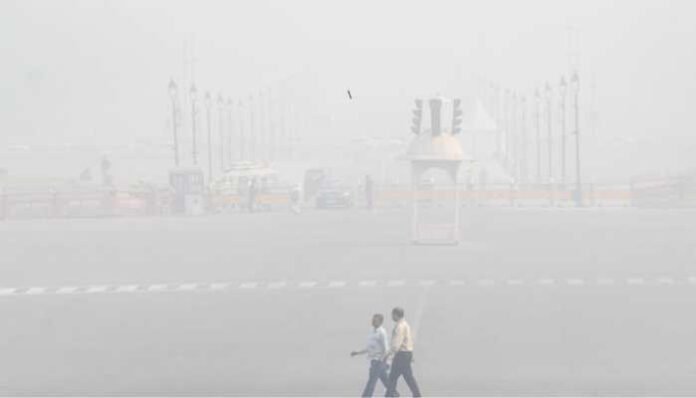As winter sets in, Delhi finds itself once again grappling with a severe air pollution crisis. Thick layers of smog have enveloped the city, reducing visibility, creating health risks, and impacting daily life. With the Air Quality Index (AQI) consistently falling into the “severe” category in several parts of the capital, residents are facing hazardous air quality levels, prompting concern and urgency among health officials, environmentalists, and policymakers. The toxic haze that blankets Delhi each year has reignited calls for immediate and long-term solutions to address what has become an annual public health emergency.
Current Status of Air Quality in Delhi
According to data from monitoring stations across the city, the AQI in various parts of Delhi has plummeted to “severe” levels, with readings exceeding 400 on the AQI scale. The “severe” category is the worst classification on the AQI, indicating extremely poor air quality that poses significant health risks to the entire population. At this level, even healthy individuals can experience respiratory issues, while those with pre-existing conditions face exacerbated symptoms.
Several factors have contributed to the worsening of Delhi’s air quality. Seasonal stubble burning in neighboring states, vehicular emissions, industrial pollutants, and construction dust combine to create a dangerous cocktail of pollutants, including particulate matter (PM2.5 and PM10), nitrogen dioxide, sulfur dioxide, and carbon monoxide. The cold weather further aggravates the situation by trapping pollutants closer to the ground, creating a “temperature inversion” that prevents these harmful particles from dispersing.
Health Impacts of Severe Air Pollution
With the AQI at “severe” levels, the health implications for Delhi’s population are profound and far-reaching. Airborne particulate matter, particularly PM2.5, is known to penetrate deep into the lungs and enter the bloodstream, potentially causing respiratory and cardiovascular issues. According to the World Health Organization (WHO), prolonged exposure to high levels of PM2.5 can lead to diseases such as asthma, chronic bronchitis, and heart attacks, and it is associated with increased mortality rates. For vulnerable populations, including children, the elderly, and those with pre-existing health conditions, the risks are even higher.
In response, Delhi’s health authorities have issued advisories urging residents to take preventive measures, such as staying indoors, using air purifiers, and wearing N95 masks when venturing outside. Schools are also considering closures or restricting outdoor activities to protect students from exposure to hazardous air quality.
Immediate Steps Taken by Authorities
In light of the current situation, both the Delhi government and the central government have implemented a series of immediate measures to reduce pollution levels. The Delhi government has activated the Graded Response Action Plan (GRAP), a multi-tiered strategy that includes banning construction activities, restricting truck entry into the city, and shutting down certain industrial operations. GRAP’s aim is to lower pollution levels through targeted actions based on real-time air quality data.
Additionally, the “Red Light On, Gaadi Off” campaign has been intensified, urging drivers to turn off their engines at traffic signals to curb emissions. Authorities have also limited the use of diesel generator sets and increased the number of water-sprinkling machines to settle dust on roads. These measures, however, are often criticized as temporary band-aids rather than lasting solutions, with many experts arguing that a more sustained, year-round approach is necessary to tackle the roots of the pollution crisis.
The Role of Stubble Burning and Crop Residue
A significant contributor to Delhi’s pollution crisis is stubble burning in the neighboring states of Punjab and Haryana. Each winter, farmers burn crop residue left over after the harvest, generating large quantities of smoke that are carried by winds to Delhi. Despite government efforts to curb this practice, including subsidies for machinery that can manage crop residue without burning, enforcement remains a challenge. Many farmers, citing economic constraints, continue to resort to burning as a quick and cost-effective solution.
Efforts to address stubble burning at a structural level have included the promotion of bio-decomposers, the implementation of fines, and incentives for alternative practices. However, the impact of these measures has been limited, and air quality continues to suffer as a result.
Long-Term Solutions and Public Response
The annual recurrence of severe air pollution in Delhi has sparked public outrage and calls for lasting policy changes. Environmentalists and public health advocates stress the need for comprehensive measures to address the root causes of pollution, including stricter emissions standards for vehicles, an expansion of public transportation infrastructure, and a transition to cleaner energy sources for industries and households.
Further, experts advocate for a collaborative, inter-state approach that involves neighboring states in developing cohesive policies for pollution management. Improved waste management practices, stricter regulation on construction activities, and continued support for farmers to reduce stubble burning are essential elements of a sustainable solution.
The Path Forward
While emergency measures may offer temporary relief, Delhi’s battle with air pollution requires a paradigm shift in how pollution control is approached. With continued population growth and urbanization, sustainable urban planning, and strong regulatory policies are essential to achieving cleaner air.
As smog persists over the capital, residents and authorities alike are grappling with the urgent need for a healthier environment. Moving beyond short-term fixes, Delhi’s pollution crisis calls for a concerted and sustained effort from all stakeholders. Only then can the capital hope to breathe freely in the winters to come.

